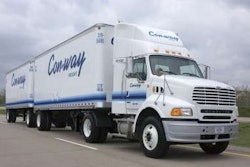Rate at lowest level since 1975, FHWA says
Figures released by the Federal Highway Administration indicate that the truck-involved fatality rate in 2007 declined 5.8 percent to 2.12 per 100 million miles from 2.25 per 100 million miles in 2006. Since new hours-of-service regulations took effect in 2005, the truck-involved fatality rate has come down more than 10 percent and is at its lowest since records began to be kept in 1975.
The truck-involved fatal crash rate and the truck-occupant fatality rate also declined from 2006 to 2007. The truck-involved fatal crash rate declined 4.5 percent to 1.85 per 100 million miles, and the truck-occupant fatality rate declined 1.98 percent to 0.35 per 100 million miles.
These crash rates are based on FHWA’s figures that report vehicle miles traveled by truck increased in 2007 to 226.96 billion miles from 222.5 billion in 2006; during that same time, the actual number of truck-involved fatal crashes fell to 4,190 from 4,321.
“This achievement is great for all of us who travel our nation’s highways,” says Bill Graves, American Trucking Associations president and chief executive officer. “The trucking industry remains committed to safety, and ATA will continue to advance its aggressive safety agenda in an effort to continue this outstanding trend.”
PHH Arval launches truck risk, safety program
PHH Arval (www.phharval.com) announced the launch of a comprehensive risk and safety program geared toward medium and heavy trucks and equipment. Designed to cover the whole spectrum of risk and safety needs for commercial truck fleets, PHH says its Truck Risk and Safety program identifies high-risk drivers, provides effective and targeted driver training, and efficiently manages the risk and costs of collisions that do happen.
PHH says the program includes various services that can be delivered as standalone offerings or in any combination, including collision prevention, identification of high-risk drivers, accident management and classroom- and simulator-based driver training.
Preventable or not:Doe too slow for sports car’s taste
John Doe kept hitting the tuner on his satellite radio in his straight truck, but everywhere the dial settled, all he heard was another talk show, and all they were talking about was the recession. Doe had just about had it with the seemingly 24/7 recession chatter – whether it was his radio, his CB buddies or any TV at any diner where he stopped for a bite and a break, it was recession this, recession that.
Sure, Doe wanted the economy to turn around just like everyone else, but he also enjoyed a good song or a little sports chatter, and both were hard to find at 10 a.m. on a clear April morning as he headed westbound on a three-lane one-way road in Chicago. Since the highway department was repairing portions of the right lanes, Doe hugged the left lane and “proceeded with caution at a slow speed,” according to his statement. A moment before the accident, the driver of a 2008 yellow Dodge Charger in the far right lane saw the construction ahead and suddenly accelerated into the outside lane, attempting to squeak past Doe’s slow-moving truck.
Recently involved in a previous crash, the Charger’s driver – 17-year-old hotshot Johnny Ziponby – was wearing a neck brace and unable to turn his head to check clearances. Consequently, Ziponby sideswiped the right front bumper of Doe’s truck and further damaged the already-dented rear of his hot rod. In contrast, the only damage to Doe’s truck was chipped paint on the right front fender.
Doe told his safety director that anticipating the other driver’s split-second and irrational maneuver in time to avoid a collision was impossible. The Accident Review Committee of the National Safety Council disagreed, noting that Doe should have sized up the situation and expected that Ziponby either might stop or veer into his lane. That is, Doe should have been prepared to yield.
In Brief
Federal Motor Carrier Safety Administration is hosting on its website safe driving tips, including video clips, for commercial motor vehicles. The videos were recorded during a driving study conducted by the Virginia Tech Transportation Institute showing examples of driver errors. To find the tips, go to www.fmcsa.dot.gov and search “CMV Web-Based Driving Tips.”
Qualcomm Inc. (www.qualcomm.com) and Instructional Technologies Inc. (www.instructiontech.net) announced that they are working together to offer ITI’s Pro-Tread Training Series on the new Qualcomm Mobile Computing Platform 200 Series. The multimedia training covers safety, regulatory and hazardous materials topics.
GE Capital Solutions Fleet Services (www.gefleet.com) says its expanded accident services reporting provides customers with data, analytics and a detailed overview of their total accident-related expenses to identify opportunities to reduce vehicle accident costs and risks.
KellerOnline (www.kelleronline.com) – an online safety management tool from J.J. Keller & Associates Inc. – added industry-specific information to its topic index to help provide subscribers with a greater ability to make decisions surrounding their safety programs.
YRC Inc. – the name of the recently merged Yellow and Roadway – said that Arthur Cage became the only truck driver in company history to achieve 5 million accident-free miles. Cage, 62, has driven for Roadway for more than 35 years and is a line-haul driver working out of the company’s service center in Memphis, Tenn.













